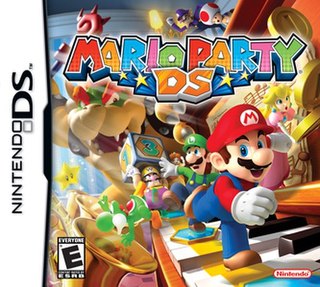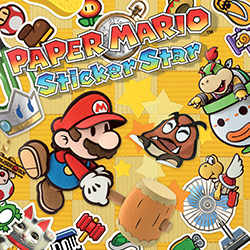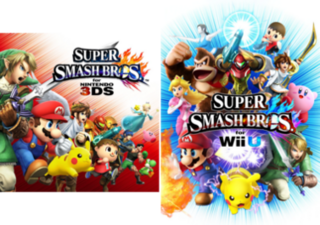Mario Kart is a series of kart racing games and a spin-off Mario franchise developed and published by Nintendo. Players compete in go-kart races while using various power-up items. It features characters and courses mostly from the Mario series as well as other gaming franchises such as The Legend of Zelda, Animal Crossing, F-Zero, Excitebike, and Splatoon.

Mario Kart: Super Circuit is a 2001 kart racing game for the Game Boy Advance (GBA). It is the third Mario Kart game and retains its predecessors' gameplay: as a Mario franchise character, the player races opponents around tracks based on locales from the Super Mario platform games. Tracks contain obstacles and power-ups that respectively hamper and aid the player's progress. Super Circuit includes various single-player and multiplayer game modes, including a Grand Prix racing mode and a last man standing battle mode.

Mario Party is a party video game series featuring characters from the Mario franchise in which up to four local players or computer-controlled characters compete in a board game interspersed with minigames. The games are currently developed by NDcube and published by Nintendo, being previously developed by Hudson Soft. The series is known for its party game elements, including the often unpredictable multiplayer modes that allow play with up to four, and sometimes eight, human players or CPUs.

The Mario franchise is a video game series created by Nintendo. Nintendo is usually the developer and publisher of the franchise's games, but various games are developed by third-party companies, such as Hudson Soft and Intelligent Systems. Games in the Mario franchise primarily revolve around the protagonist Mario and often involve the trope of Bowser as the antagonist kidnapping Princess Peach, with Mario then rescuing her. Many characters have goals or plot arcs that vary between series; for example, the Luigi's Mansion games focus on Luigi ridding a haunted building of ghost-like creatures known as Boos, and Wario stars in games that center around his greed and desire for money and treasure.

Bowser Jr. is a fictional character who appears in Nintendo's Mario franchise as an antagonist. He is the son of the series' main antagonist, Bowser. Since his debut in Super Mario Sunshine in 2002, Bowser Jr. has been a recurring character in the Mario series and has been made playable in several spin-offs, such as Mario Superstar Baseball, Mario Strikers Charged, Super Smash Bros. for Nintendo 3DS and Wii U, and Super Smash Bros. Ultimate among many others. He often helps his father to kidnap Princess Peach and defeat Mario, but in the end wants nothing more than to impress his father. Bowser Jr.'s defining traits are his striking resemblance to his father, his energetic and driven personality, his expertise in mechanics and technology, his heavy uses of his Junior Clown Car and Magic Paintbrush, and the bib-like bandana he wears.
Super Smash Bros. is a crossover fighting game series published by Nintendo. The series was created by Masahiro Sakurai, who has directed every game in the series. The series is known for its unique gameplay objective which differs from that of traditional fighters, in that the aim is to increase damage counters and knock opponents off the stage instead of depleting life bars.

Super Mario is a platform game series created by Nintendo starring their mascot, Mario. It is the central series of the greater Mario franchise. At least one Super Mario game has been released for every major Nintendo video game console. However there have also been a number of Super Mario video games released on non-Nintendo gaming platforms. There are more than 20 games in the series.

Mario Party DS is a 2007 party video game developed by Hudson Soft and published by Nintendo for the Nintendo DS. It is the second handheld game in the Mario Party series, as well as the last game in the series to be developed by Hudson Soft, as all subsequent titles have been developed by NDcube. The game was later released on the Virtual Console for the Wii U in April 2016.

Mario is a Japanese multimedia franchise created by Japanese game designer Shigeru Miyamoto for video game company Nintendo which produces and publishes its installments. Starring the titular Italian plumber Mario, it is primarily a video game franchise, but has extended to other forms of media, including television series, comic books, a 1993 feature film, a 2023 animated film and theme park attractions. The series' first installment was 1983's Mario Bros., although Mario had made his first appearance in 1981's arcade game Donkey Kong, and had already been featured in several games of the Donkey Kong and Game & Watch series. The Mario games have been developed by a wide variety of developers including Nintendo, Hudson Soft, and AlphaDream. Mario games have been released almost exclusively for Nintendo's various video game consoles and handhelds, from the third generation onward.

Style Savvy, known as Nintendo presents: Style Boutique in the PAL region and as Wagamama Fashion: Girls Mode in Japan, is a fashion video game developed by Syn Sophia and published by Nintendo. It was released for the Nintendo DS on October 23, 2008 in Japan, on October 23, 2009 in Europe, and November 2, 2009 in North America. The game is followed up by three sequels for the Nintendo 3DS called Style Savvy: Trendsetters, Style Savvy: Fashion Forward, and Style Savvy: Styling Star.

Paper Mario: Sticker Star is an action-adventure role-playing video game developed by Intelligent Systems and published by Nintendo for the Nintendo 3DS. It is the fourth installment in the Paper Mario series and part of the larger Mario franchise; it is the first game in the series released on a handheld console. In the game, the protagonist Mario and a new ally named Kersti travel across the Mushroom Kingdom to retrieve the six Royal Stickers scattered by Bowser. The game was released in November 2012 in North America and December 2012 overseas.

Super Smash Bros. for Nintendo 3DS and Super Smash Bros. for Wii U are 2014 crossover platform fighter video games developed by Bandai Namco Studios and Sora Ltd. and published by Nintendo for the Nintendo 3DS and Wii U video game consoles. It is the fourth installment in the Super Smash Bros. series, succeeding Super Smash Bros. Brawl. The Nintendo 3DS version was released in Japan on September 13, 2014, and in North America, Europe, and Australia the following month. The Wii U version was released in North America, Europe, and Australia in November 2014 and in Japan the following month.

New Super Mario Bros. 2 is a 2D side-scrolling platform video game in the New Super Mario Bros. series developed by Nintendo EAD Group No. 4 and published by Nintendo for its Nintendo 3DS handheld video game console, being released first in Japan on July 28, 2012. It is a direct sequel to the 2006 Nintendo DS game New Super Mario Bros. and is the first Nintendo-published game to be released simultaneously in both downloadable and physical forms.

Style Savvy: Trendsetters, known as Nintendo presents: New Style Boutique in the PAL region, as Wagamama Fashion: Girls Mode Yokubari Sengen! in Japan, is a fashion video game developed by Syn Sophia and published by Nintendo and a sequel of the Nintendo DS game Style Savvy. It was released for the Nintendo 3DS on September 27, 2012 in Japan, on October 22, 2012 in North America and November 16, 2012 in Europe.

Mario Party: Island Tour is a party video game developed by NDcube and published by Nintendo for the Nintendo 3DS. The third handheld game in the Mario Party series, it was announced by Satoru Iwata in a Nintendo Direct presentation in April 2013, and was released in November 2013 in North America, in January 2014 in Europe and Australia, and in March 2014 in Japan. The game features seven boards, each with their own special features, and 81 new minigames. It was followed by Mario Party 10 for the Wii U in 2015.
Amiibo is a toys-to-life platform by Nintendo, which was launched in November 2014. It consists of a wireless communications and storage protocol for connecting figurines to the Wii U, Nintendo 3DS, and Nintendo Switch video game consoles. These figurines are similar in form and functionality to that of the Skylanders, Disney Infinity and Lego Dimensions series of toys-to-life platforms. The Amiibo platform was preannounced to potentially accommodate any form of toy, specifically including general plans for future card games. amiibo use near field communication (NFC) to interact with supported video game software, potentially allowing data to be transferred in and out of games and across multiple platforms.

Paper Mario: Color Splash is a 2016 action-adventure role-playing game developed by Intelligent Systems and published by Nintendo for the Wii U console. It is the fifth installment in the Paper Mario series, within the larger Mario franchise. The story follows Mario and his new ally Huey on a quest to save Prism Island and rescue Princess Peach from Bowser.

Mario Party: Star Rush is a party video game developed by NDcube and published by Nintendo for the Nintendo 3DS. It is the fourth handheld game in the Mario Party series. The game features a new party mode known as Toad Scramble which deviates from the normal Mario Party series in its removal of turn-based gameplay in favor of the ability to move at will, simultaneous with other players, and without set paths on the game board.

Style Savvy: Fashion Forward, known as Girls Mode 3: Kirakira Coord in Japan and as Nintendo Presents: New Style Boutique 2 − Fashion Forward in the PAL region, is a fashion-themed simulation video game developed by Syn Sophia and published by Nintendo in Japan, Europe and Australia in 2015, and in North America in 2016. It is the third installment in the Style Savvy series, following Style Savvy (2008) and Style Savvy: Trendsetters (2012), and it is followed by Style Savvy: Styling Star (2017). It was well received by critics.
















